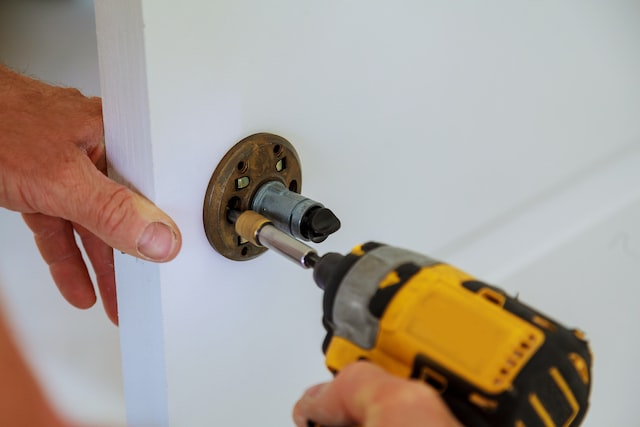If you have trouble finding out how to fix a loose door knob, you are not alone. The problem can be frustrating and can prevent you from using the locks on your doors. But there are steps you can take to solve the problem.
Tightening the set screw
If you notice that your door knob is jiggly or rattling, you may need to tighten the set screw. This will lock the knob into position and prevent unnecessary wear and tear on the screws. You should also test the knob to ensure it is functioning properly.
The set screw is a small hexagonal-shaped screw that locks the knob into place and keeps it from spinning on the spindle. It may be recessed or have a flat head. Before you attempt to tighten the set screw, you should clean it to remove any dirt and oil that might have accumulated over time.
When you have located the set screw, you can start the process of tightening it. You can do this with the help of a Phillips or hex key. Depending on the type of screw, you should use the appropriate screwdriver.
You can also remove the knob to access the set screw. Alternatively, you can remove the faceplate and remove the screws that hold the mechanism together. However, you should not damage the screws.
To remove the knob, you can take a flathead screwdriver and use it to pry it off. Use a light source to illuminate the knob. A small flashlight will help you see the set screw.

Image by Unsplash+
Tightening the long screws that secure the lockset to the door
If your doorknobs are wobbling or not working as well as they should, then it may be time to tighten the long screws that connect the lockset to the door knob. You should not damage the screw slot, but you should tighten the screws with force.
Door knobs have two mounting screws, one for the interior and the other for the exterior. The interior knob is typically attached to the spindle with a detent button. The button is near the surface of the shaft, which keeps the knob from rotating on the spindle.
Occasionally, the knob will come off, and you can remove it by using a small flathead screwdriver. To do this, you must first unscrew the set screw. Once the set screw is removed, you can loosen the backing plate and pull the handle out of the spindle.
You can also use a toothpick to tighten loose wood screws. If the screw holes are hollow, you can fill them with a cloth or alcohol to remove any oil residues.
Kwikset knobs, which are less common, have a long screw that passes through the spindle. This allows you to access the long screws on the other side of the lockset.
Some doorknobs have a hidden pin hole. Usually, you can tighten these screws by turning them clockwise. However, in some cases, you might have to remove the knob and turn the screw in the other direction.

Photo by Tucker Good on Unsplash
Identifying the detent access hole
If your door knob is not moving properly, it could be that the detent is loose. It is a spring-activated pin that keeps the knob from twisting on the door.
Fortunately, it is fairly easy to fix this problem. First, find the access hole. This is a small hole, usually on the side of the knob.
After locating the access hole, remove the cover plate from the knob. This will allow you to remove the internal screws. You may want to use a wire brush to clean the area before you begin.
The next step is to replace the set screw. These screws hold the doorknob together. They should be replaced if they are broken or if the screw is loose. A small Allen wrench is perfect for this task.
Once the screws are replaced, you should check to see if the doorknob is still working. In most cases, you will need to adjust the handle. To do this, you will need to loosen the ring. Use a flat head screwdriver to ease the ring.
Another way to do this is to remove the base of the knob. Often, this is done by twisting the shaft, which allows you to reach the base and spin it out.
Next, locate the detent. Some knobs have a slotted or recessed hole. On other knobs, you will have to press the detent to reach the mounting screws.
